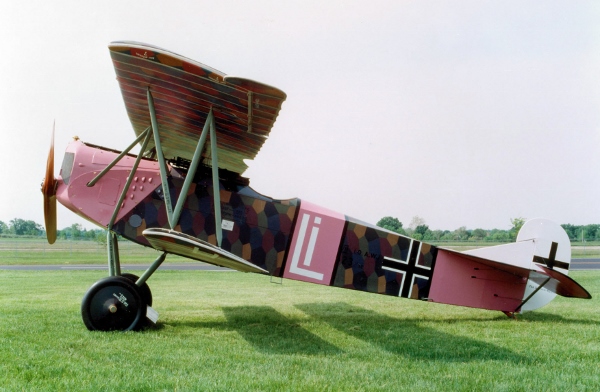
|
 |
Fokker D.VII |
 |
 |
 |
 |
 |
|---|---|---|---|---|---|---|---|
 |
 |
 |
 |
 |
|||
 |
||
|
In January 1918 a competition open to single-seater fighters powered by the 160 hp Mercedes engine was held at Johannisthal, near Berlin. It was won outright by an angular little biplane with thick cantilever wings, the
Fokker D.VII, designed by Reinhold Platz. Unquestionably the best all-round German fighter of the First World War, it was a development of Platz's experimental V.II, built late in 1917.
Its engine was either the 160/180 hp Mercedes or the 185 hp BMW, neatly cowled and fitted with a frontal radiator. BMW D.VIIs had the better performance and were much sought after. The 200 hp Benz was experimentally fitted without great success. The exhaust system was either the usual external horizontal pipe on the starboard side, or separate internal pipes connected to a large main pipe which protruded through the starboard cowling. |
| D.VII wings had two spars with plywood ribs; the leading-edges were of ply, the rest of the structure fabric covered. Unequal chord ailerons framed in steel tubing, were fitted to the upper wing only, which had a slight curved cutout in its trailing-edge. The lower wing was housed in a recess in the fuselage bottom; both planes had wire trailing-edges, giving *em a 'scalloped' appearance. Interplane and center section struts were of streamlined steel tubing. |

The fuselage was constructed of wire-braced welded steel tubing with a three-ply top decking behind the cockpit; the whole being fabric-covered, except for the engine cowlings. Fin, balanced rudder, tailplane and balanced elevators were also of fabric-covered steel tube. Two struts braced the tailplane from below. The undercarriage was of streamlined steel tube and its axle was enclosed in a large fairing which gave some extra lift.

Twin Spandau guns were synchronized to fire through the revolving propeller. Following its success at Johannisthal, the type was ordered in large quantities; not only was it built by the Fokker concern (Fok. D.VII F), but also by its rivals, the Albatros Werke (Fok. D.VII (Alb.)) and the Ostdeutsche Albatros Werke (Fok. D.VII (OAW)). Mercedes and BMW engines appear to have been distributed impartially to all three companies. While not especially fast, the D.VII's strong point was its great maneuverability at high altitudes. It was extremely easy to fly and had no terrors for the beginner. Jagdgeschwader Nr. 1, the Richthofen 'Circus', received the first D.VIIs in time for the Second Battle of the Aisne in May 1918, and soon found that the new type gave them a good margin of advantage over their opponents. By the autumn the majority of the Jastas had been reequipped with D.VIIs. So highly did the Allies esteem the machine that their Armistice terms specifically ordered the surrender of all Fokker D.VIIs. As a safeguard against a possible shortage of steel tubing and competent welders, the Albatros company built a D.VII with a plywood fuselage, but it was not found necessary to produce this variant. When the war ended, production of the type for Austro-Hungary had begun at the Hungarian Engineering Factory, Budapest (MAG). Total production was approximately 3,300 aircraft. |
© The Aviation History On-Line Museum.
All rights reserved. | ||||||||||||||||||||||||||||||||||||||||||